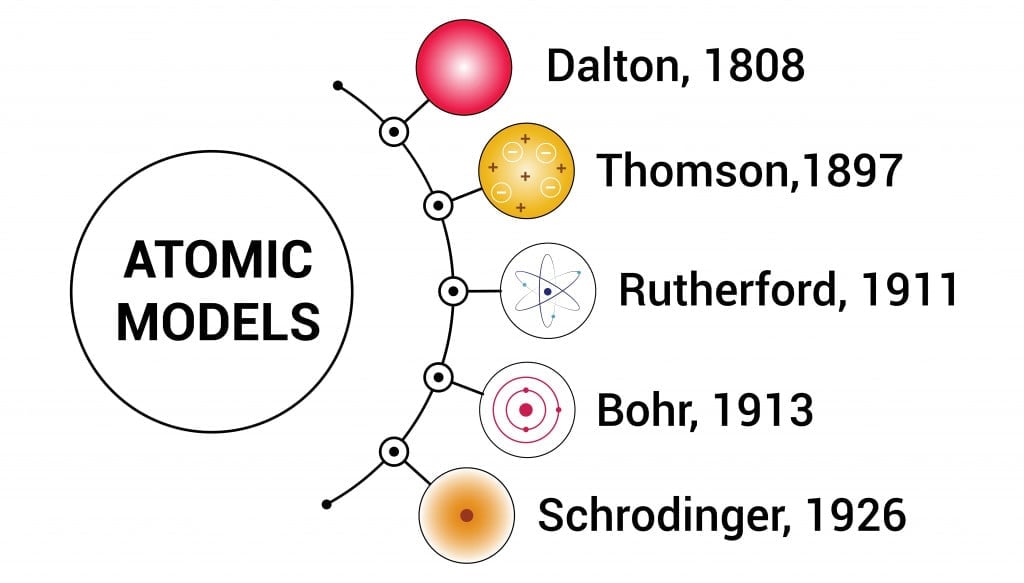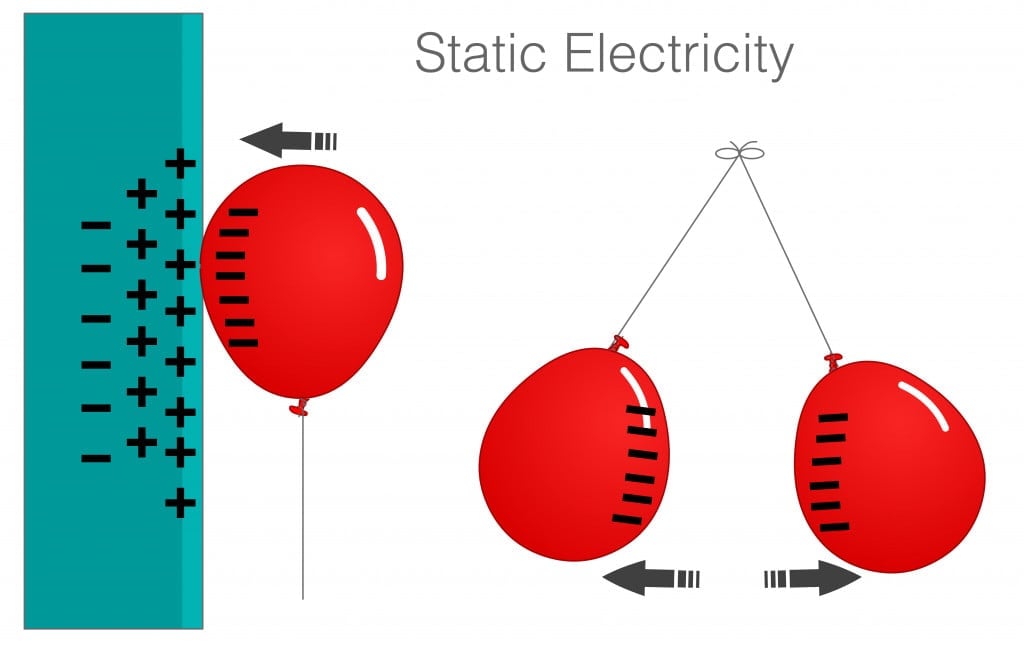Do Electrons And Protons Attract
Dissimilar charges are attracted to each other, but protons and electrons within the space of an cantlet exercise not interact with each other. Quantum physics attempts to explicate the reason behind the absenteeism of this forbidden interaction.
The foundation of the question " Why do electrons not collide with protons?" comes from the Rutherford planetary model of an atom.
This is an overly simplified model of an atom as a central dumbo nucleus consisting of protons and neutrons, with electrons revolving around the nucleus, an idea structured on the solar arrangement. Breakthrough physics attempts to explain this interaction less abstractly.
Recommended Video for yous:
Rutherford model as an extension of the solar system

Planetary model of an atom (Photo Credit : Fotofolia & Shutterstock)
This model failed to explain the stability of a particle in a circular path, but it did leave an indelible question that has lingered for generations: Why don't electrons end up pulling on their protons?
Rutherford hypothesized that the stability of an electron is a residuum between the centrifugal force of the revolving electron and the bonny forces of the nucleus. It is a perfect picture hypothesis, simply unsustainable!
Why is Rutherford's planetary model invalid?
A charged particle revolving in an orbit must modify management, resulting in acceleration. A charged accelerating particle will lose energy in electromagnetic radiation, and eventually collapse into the nucleus.
Even so, this does not happen. An atom is extremely stable, and then we need to move away from classical physics and spin towards quantum physics for an answer.
Evolution of the structure of an atom

Timelines in Structure of an atom (Photo Credit : sousou07/Shutterstock)
- (1803) Dalton's billiard ball model of an atom as an indivisible entity. Today, we know that an atom is divisible into sub-atomic particles.
- (1904) Thomson'due south plum pudding model embedded electrons in a sphere of positive charges. The theory failed upon the discovery of the nucleus by Rutherford and his squad.
- (1911) Rutherford'southward nuclear model proposed that the cantlet has a pocket-size, dense, central region, called the nucleus, consisting of positively charged particles. The negatively charged electrons revolved in orbits effectually the nucleus. This model, based on the planetary model, does non explain the stability of an cantlet.
- (1913) Niels Bohr's quantum model was likewise based on a planetary model, but here, the electrons circumduct in paths with fixed energy called orbits. The spaces between the orbits are forbidden for the electron. This model rules out the spiraling of electrons into protons because of the "forbidden paths" between unlike energy levels.
Yet, the model could not explain the line spectra of atoms with more than than ane electron.
- (1926) In Schrodinger's quantum mechanical model, electrons do not move in round orbits merely exist in electronic clouds. An electron cloud is a region of infinite inside an atom, where there is a 90% probability of finding the electron; this infinite is chosen the orbital.
Schrodinger and Heisenberg put forward theories and mathematical equations for the stability of an atom, which led to the birth of quantum mechanics. According to this school of physics, the position and momentum of an electron cannot be determined simultaneously.
With the electron cloud model of an cantlet, there is no forbidden zone for electrons to cross.
Then what stops the electrons and protons of an atom from interacting?
A simple experiment can bear witness that protons and electrons of unlike atoms interact, but protons and electrons of the aforementioned cantlet practice non interact. Protons and electrons are of opposite charges, and then traditionally, they would be attracted to each other.
This is very clear from a small balloon experiment. Static electricity is an electrical phenomenon in which charged particles can be transferred from i trunk to another.

Static electricity, transient electron transfer (Photo Credit : grayjay/Shutterstock
When a balloon is rubbed confronting a sweater or a person'southward hair, the balloon gains negative charges. When the negatively charged balloon is brought close the wall, the electrons in the wall move, leaving the protons exposed, which interact with the negative charges on the airship.
When the electrons from 1 type of matter are attracted to the protons of another, then why do electron and protons within the same atom not collaborate? In theory, electrons should zoom right into the nucleus!
Odds confronting nuclear collision
Iv concepts forbid interactions betwixt protons and electrons of the same atom.
one. Kinetic and Potential Energy in atomic stability.
An electron in atomic space further away from the nucleus carries potential energy, but no kinetic energy. If the electron moves towards the proton, part of its potential energy is converted to kinetic energy and electromagnetic energy. Electrons with kinetic energy keep hopping, which prevents them from combining with a proton.
2. The terminal deck in the game: the battle of the infinities
If the electron did enter the nucleus, it still wouldn't combine with the proton. The potential energy of an electron becomes negative equally information technology approaches the nucleus and is minus infinity inside the nucleus. In contrast, the kinetic energy of electrons keeps increasing and it is positive infinity within the nucleus, which is called the confinement energy. A fall in potential free energy is twice the kinetic energy. This will make the electron hop at a distance equal to Bohr's radius, thus limiting its interaction with protons.
3. Dual nature of electrons
As per the Heisenberg principle, the location and the momentum of an electron cannot exist determined simultaneously. This is a fundamental property of microbodies, such equally electrons. And so, within the perimeter of an atom, an electron cannot be considered as a particle, but more as a wave. Thus, the electron tin can pass through the nucleus, but it cannot fall and remain in the nucleus.
4. Let's sum it up
A proton–electron matrimony must grade a neutron. Both the accuse and the mass have to match. Charge-wise, the positively charged proton volition collaborate with the negatively charged electron to form a neutron, just the match of mass is improbable. The mass of a proton is one.6726 10 10-27 kg, and the mass of an electron is 0.00091 10 10-27 kg, simply the mass of a neutron is one.6749 10 10-27 kg. The sum of the mass of an electron and proton is not equal to the mass of a neutron.
Thus, for an electron and proton to combine together to form a neutron, free energy, mass, or both must be added.
Conclusion
Electrons may occasionally enter the nucleus, but it is improbable for them to interact with protons to course a neutron. Several concepts explain the absenteeism of this fatal attraction: the battle of infinities, the wave property of electron, and the gap in the mass of a neutron to the sum of the masses of a proton and electron. The forbidden interaction of protons and electrons is a central property that keeps atoms and the Universe intact!
Suggested Reading
-
Cracking Breakthrough Physics -
Quantum Physics -
Silent Witnesses: The Often Gruesome But E'er Fascinating History of Forensic Science
Was this commodity helpful?
Aye No
Assist us brand this article ameliorate
Do Electrons And Protons Attract,
Source: https://www.scienceabc.com/pure-sciences/protons-and-electrons-have-opposite-charges-then-how-do-they-not-end-up-pulling-on-each-other.html
Posted by: bentleyangsts65.blogspot.com





0 Response to "Do Electrons And Protons Attract"
Post a Comment